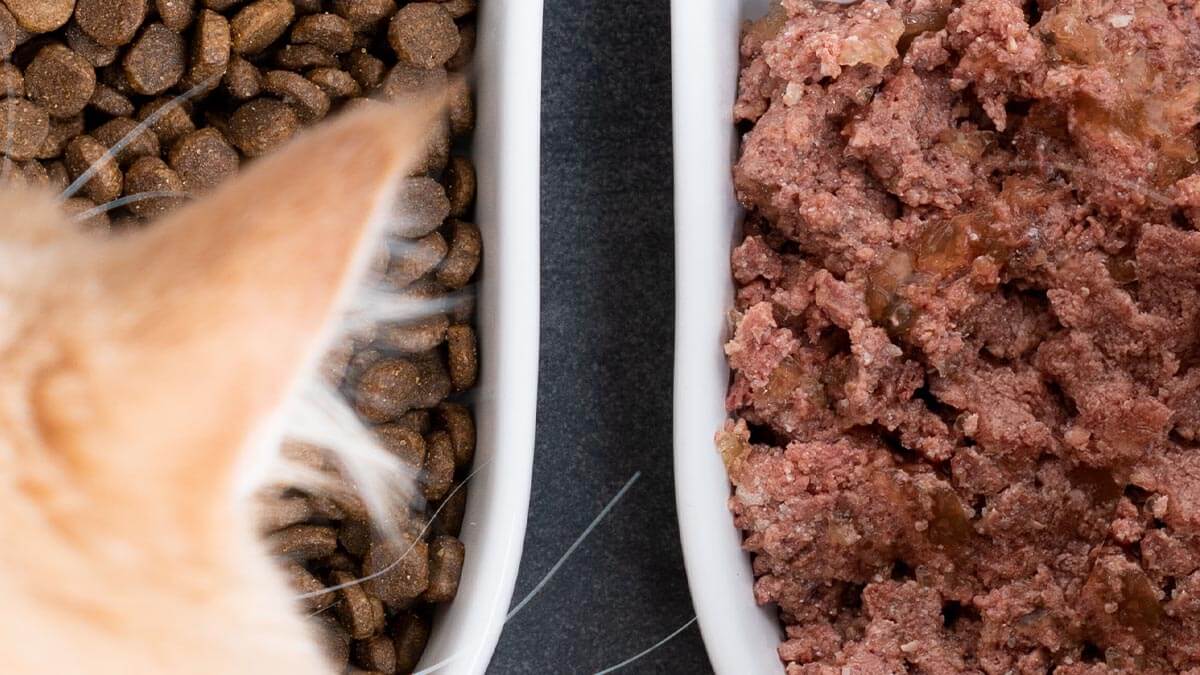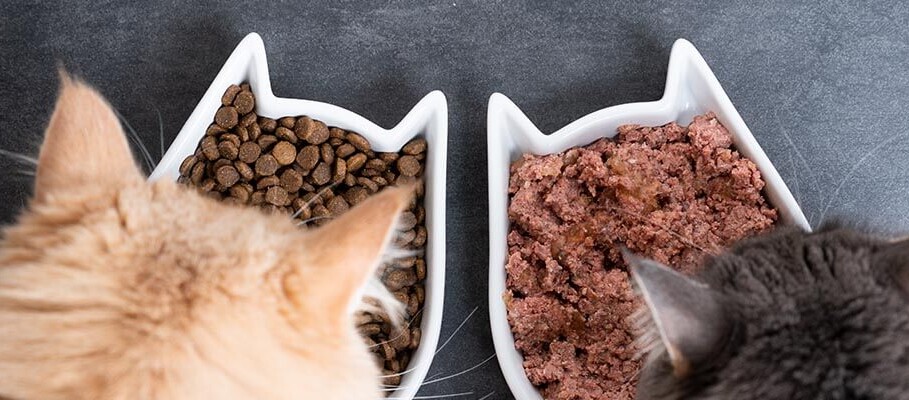Table of Content
- Hydration and palatability: key differences in food for cats
- Nutritional considerations in cat food for optimal feline health
- Specialized cat food and health concerns
- Homemade fresh food for cats
- Manufacturing and processing food for cats
- Sustainability and Sourcing in cat food Production
- Market trends and consumer preferences in food for cats
- Pro Tip
- Innovation in the food for cat market
- Conclusion
1. Hydration and Palatability: Key Differences in food for cats
One of the most significant distinctions between wet and dry food for cats lies in their moisture content. Wet cat food, typically packaged in cans or pouches, ensure a high-water content, often ranging from 75% to 85%. This inherent moisture offers several potential benefits for feline health.
Cats, by nature, are not avid water drinkers, often deriving much of their hydration from their prey in the wild. Wet food can therefore contribute significantly to a cat's overall water intake, promoting healthy kidney and urinary tract function.
Furthermore, the texture and aroma of wet food are often more appealing to cats, making it a potentially advantageous choice for cat food for fussy cats or those with dental issues that may hinder their ability to chew dry kibble.
Dry cat food, on the other hand, typically contains only around 10% moisture. While this lower water content necessitates that cats drink more water separately, it also confers advantages in terms of convenience and cost-effectiveness.
Dry food for cats can be left out for extended periods without spoiling, making it suitable for free-feeding arrangements. It is also generally more affordable than wet food, a factor that can be significant for both individual pet owners and businesses managing large-scale feeding operations.
However, it is essential to recognize the potential downsides of each format. The lower moisture content of dry food can contribute to dehydration in cats that do not drink enough water, potentially exacerbating kidney or urinary tract issues.
Conversely, the higher moisture content of wet food can sometimes lead to dental problems, as it does not provide the same abrasive action as dry kibble, which can help to reduce plaque and tartar buildup.
In addition, for B2Bs, factors such as transportation, storage and shelf-life need to be taken into account.
2. Nutritional Considerations in cat food for Optimal Feline Health
Both wet and dry food for cats can provide complete and balanced nutrition, provided they are formulated to meet the specific dietary requirements of felines. Cats are carnivores, meaning they require nutrients found primarily in animal tissues. Protein is of great importance, supporting muscle maintenance, growth, and various bodily functions.
When evaluating cat food products, B2B professionals should pay close attention to the protein sources listed on the ingredient label. High-quality animal proteins, such as chicken, turkey, fish, or beef, should be listed prominently. Plant-based proteins, while they may contribute to the overall protein content, are generally less bioavailable to cats and should not be the primary protein source.
In addition to protein, cats require specific amino acids, such as taurine and arginine, which are essential for heart health, vision, and other vital functions. These amino acids are typically found in adequate amounts in animal tissues. Reputable cat food manufacturers will ensure their products are fortified with these essential nutrients to meet feline dietary needs.
Fatty acids, including omega-3 and omega-6, are also crucial for feline health, contributing to healthy skin and coat, brain function, and inflammatory regulation. Wet and dry cat food formulations often incorporate sources of these fatty acids, such as fish oil or flaxseed.
3. Specialized cat food and Health Concerns
The cat food market offers more than just the choice between wet and dry food. B2B professionals must also consider the growing demand for specialized diets tailored to address specific health conditions in cats.
For instance, cats with diabetes may benefit from diets that are lower in carbohydrates and higher in protein. Fresh food for cats, whether commercially prepared or homemade under veterinary guidance, can be an option for diabetic cats, allowing for greater control over ingredient selection and carbohydrate content.
Kidney disease is another common ailment in older cats, often requiring dietary modifications to reduce the burden on the kidneys. Specialized renal diets are typically lower in phosphorus and protein, while still providing adequate levels of high-quality protein to maintain muscle mass. Such specialized diets may also take the form of cat food for fussy cats, to account for diminished appetite because of the disease.
Food allergies or sensitivities can also necessitate specialized diets. Limited-ingredient diets, which feature a single novel protein source and a limited number of other ingredients, can help identify and eliminate allergens from a cat's diet.
4. Homemade fresh food for cats
While commercially prepared wet and dry cat foods are the most common choices, some cat owners opt for homemade diets. This approach can offer greater control over ingredients and potentially cater to cats with specific dietary needs or preferences.
However, formulating a nutritionally complete and balanced homemade cat food requires careful planning and a thorough understanding of feline nutritional requirements.
A detailed breakdown of the essential nutrients cats need is crucial for anyone considering a homemade approach:
Protein, as mentioned earlier, is important. High-quality animal protein sources, such as cooked chicken, turkey, or fish, should form the foundation of the diet.
Essential fatty acids, including omega-3 and omega-6, are also vital. These can be provided through sources like fish oil, but careful attention must be paid to dosage to avoid imbalances.
Vitamins and minerals are equally essential. Calcium, phosphorus, potassium, magnesium, and various B vitamins are just a few of the micronutrients that must be present in appropriate amounts. Organ meats, such as liver and kidney, can provide some of these nutrients, but supplementation may be necessary to ensure a complete and balanced diet. For instance, studies on nutritional adequacy of home-prepared fresh food for cats, such as the ones published on the website of the Journal of Feline Medicine and Surgery (in English) are a good start for suppliers looking to develop a new product.
It is strongly recommended that anyone considering a homemade cat food diet consult with a veterinarian or a veterinary nutritionist. They can provide guidance on appropriate ingredient selection, portion sizes, and supplementation to ensure the diet meets the cat's specific needs.
5. Manufacturing and Processing food for cats
From a B2B perspective, the manufacturing processes for wet and dry cat food differ significantly, impacting production costs, shelf life, and logistical considerations.
Dry cat food production typically involves a process called extrusion. Ingredients are mixed, heated, and forced through a die under high pressure, creating the familiar kibble shapes. This process cooks the ingredients and imparts a long shelf life to the final product. Dry cat food is also generally more cost-effective to produce and transport due to its lower weight and volume compared to wet cat food.
Wet cat food production, on the other hand, involves mixing ingredients and then sealing them in cans or pouches, followed by a heat sterilization process. This method ensures the product is shelf-stable without the need for refrigeration until opened. However, the higher water content and packaging requirements make wet food production typically more expensive than dry food.

6. Sustainability and Sourcing in food for cat Production
Sustainability is an increasingly important consideration for B2B professionals in the cat food industry. Consumers are becoming more conscious of the environmental impact of their purchasing decisions, and this awareness extends to pet food.
Sourcing ingredients responsibly is a key aspect of sustainable cat food production. Utilizing byproducts from the human food industry, such as organ meats that might otherwise be discarded, can help reduce waste and improve the overall sustainability of the supply chain.
Additionally, sourcing fish from sustainable fisheries, certified by organizations like the Marine Stewardship Council, is crucial for preserving marine ecosystems.
Packaging choices also play a significant role. Exploring alternatives to traditional plastic packaging, such as biodegradable or compostable materials, can help reduce the environmental footprint of cat food products.
7. Market Trends and Consumer Preferences in food for cats
The cat food market is constantly evolving, driven by changing consumer preferences and advancements in pet nutrition science. B2B professionals need to stay aware of these trends to remain competitive.
One notable trend is the growing demand for natural and organic cat food products. Consumers are increasingly seeking out foods for cats that are free from artificial colors, flavors, and preservatives. This trend aligns with the broader movement towards cleaner labels and greater transparency in food production.
Another trend is the rise of limited-ingredient diets, driven by a growing awareness of food allergies and sensitivities in cats. These diets appeal to pet owners seeking simpler formulations with fewer potential allergens.
The humanization of pets is also influencing the cat food market. Pet owners are increasingly treating their cats as members of the family and are willing to spend more on premium and super-premium foods that offer perceived health benefits, and more especially on cat food for fussy cats.
8. Pro Tip
For B2B professionals looking to optimize their cat food offerings, consider investing in research and development to create specialized formulas that cater to specific health conditions. For example, develop a line of dry food for cats specifically designed for senior cats, addressing issues like joint health, cognitive function, and weight management.
Request a consultation to our team and discover how to effectively promote your cat food products on our platform.
.png)
9. Innovation in the food for cats market
The cat food industry presents a dynamic and evolving landscape for B2B professionals. Staying ahead of the curve requires a commitment to innovation, a deep understanding of feline nutritional needs, and a keen awareness of market trends.
New scientific studies about cat health, the evolving demands of cat owners, and innovations within the cat food industry are constantly influencing each other. This continuous change will define the future of the food for cats' industry.
The companies that will do best are the ones that can quickly react to new scientific information, adapt to what customers want, and develop new products accordingly. Agility and responsiveness are key to success.
Get tailored quotes from cat food suppliers that match your specific requirements. Start now by using our "Request for Quotes" page.

10. Conclusion
The choice between wet and dry food for cats is not a simple one, as both formats offer distinct advantages and disadvantages.
For B2B professionals in the food or cats’ industry, understanding these nuances is essential for developing successful products, making informed sourcing decisions, and implementing effective marketing strategies.
While wet food excels in hydration and palatability, dry food for cats offers convenience and cost-effectiveness. Both can provide complete and balanced nutrition when formulated appropriately.
Ultimately, the best choice for an individual cat may depend on a variety of factors, including age, health status, and personal preference. The growing demand for specialized diets highlights the need for B2B professionals to stay informed about emerging trends and cater to the diverse needs of cat owners. New innovations will surely emerge to further bridge the gap between these two formats, offering the best of both worlds to discerning cat owners and their feline companions.
Find Cat food solutions for your project!
- BECKERCOMPLAN GMBH offers diverse, high-quality pet products, including various dry and wet foods for dogs and cats, horse feed, and supplements.
- NORMPATI PET FOOD produces high-quality, innovative, and reliable pet food, driven by ethical values and a commitment to animal health. Operating from a large facility in Izmir Torbalı, they export to over 50 countries, prioritizing customer satisfaction and responsible production.
- D STOCK AFFAIRES is a leading French wholesaler specializing in food product clearance and supporting charitable donations. They offer a wide range of products, including fruits, vegetables, beverages, and snacks, at competitive prices to all professional buyers through their online platform.
- MCPRO GIDA has been producing high-quality cat and dog food for over a decade, exporting carefully formulated recipes to Europe and around the globe.
- GÜLLÜK PET FOOD & PRODUCTS a major Turkish pet product exporter, offers high-quality cat, dog, and bird food, cat litter, and accessories. Established in 1997, their brands are globally recognized, thanks to their commitment to using the best raw materials.
- EFFEFFE PET FOOD TURKIYE has rapidly become a top Turkish animal food producer by capitalizing on emerging trends and its multifaceted experience. They leverage over 30 years of expertise to maintain European-standard production quality.
- VITALIZE SAINTHUBERT SAS BOYER a French company, offers a wide range of veterinarian-developed cat kibble, including grain-free options for sensitive pets. With 25 years of experience, their quality is trusted by pet professionals and owners alike.
- KARNAVAL AMBALAJ GIDA VE YEM SAN. TIC. LTD. ŞTI a leading brand since 2009, offers a wide range of high-quality pet food enhanced with scientifically backed formulas. Using advanced packaging technology ensures freshness and taste.
- PELAGOS AKVARYUM SAN. TIC. LTD. ŞTI. a major Turkish pet product exporter, offers high-quality cat food. Established in 1980, their cat food brand is globally recognized thanks to their access to premium raw materials.
- HOURAL'S FOOD provides high-quality animal nutrition solutions, including Economic, Grain-Free, Premium, and Super Premium options. They cater to breeders and other professionals, offering tailored ranges for puppies and kittens, and ensuring ingredient quality without compromise.
- SPECIALMIX MIGLIONICO S.R.L. utilizes both expert advice and personal experience to produce natural animal feed. Their extensive product line includes cat kibble made with carefully selected, locally sourced ingredients.
- ESPACE PASSION FRANCE is a super-premium French brand offering veterinarian-formulated kibble for cats. Known for its high-quality ingredients, palatability, and grain-free options, the brand is led by animal nutritionist Daniel Détraz and also offers a range of dietary supplements.

